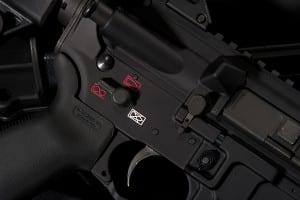
The ambidextrous bolt release and safety lever on the LWRC SIX8 are so well-executed they look like Eugene Stoner himself designed them that way. The author wonders when other companies will start paying more attention to lower receivers. (Photo by Richard King)
A few days ago I had the opportunity to visit LWRC International in Cambridge, Md. LWRCI has become well-known and respected for its short-stroke piston design incorporated into AR rifles. The company was one of the early pioneers of piston systems on ARs when this operating system came back into vogue.
Recently the firm also took an interesting step away from the norm when it cast aside the 5.56×45 specifications and designed an AR around the dimensions of the 6.8 SPC cartridge. In doing so, the designers rid themselves of the limitations of the 5.56×45 magazine-well dimensions and optimized the design specifically for the 6.8×43 cartridge. Make no mistake; this was a big step.
While the piston system and new SIX8 rifle are impressive, what really caught my attention were the ambidextrous controls. Rather than being aftermarket parts bolted on as an afterthought, the lower receiver is designed with this capability in mind. The rifle sports a bolt release, safety and magazine release on both sides of the rifle as well as an ambidextrous charging handle.
The controls are designed in such a way to make them truly useful for both a right-handed or left-handed shooter. As an example, the bolt release on the right side of the rifle allows a right-handed shooter to lock the bolt back or release the bolt easily from a firing grip. This is a handy feature to have.
To date, only a couple of companies have taken the time to redesign the lower receiver’s controls in this manner. In stark contrast it seems like every AR company under the sun has done a great deal of work on tweaking and modifying the upper receiver.
You can get long or short barrels in any weight or contour you can think of, a variety of gas system lengths, a bewildering array of handguards, piston systems, direct gas or blow-back operating systems for all sorts of calibers plus every muzzle device you can think of. But when you have finally spec’d out your dream upper you then stuff it onto a traditional lower receiver basically unchanged since the 1960s. Why is that? It doesn’t make sense to me.
Considering what an important piece the lower receiver is, I am somewhat perplexed at why more companies haven’t looked at bringing it into the 21st century. It’s obvious by the growing proliferation of aftermarket ambidextrous parts that the market would support such a move.
It’s also interesting to note this is actually how Magpul began work on what eventually evolved into the Masada/ACR rifle. Years ago when Magpul first showed this eye-catching design, company officials spoke at length about how they undertook developing a rifle. What is interesting is they didn’t originally plan on designing an entirely new rifle. Instead they just intended on upgrading and modifying the AR-15 system.
An important part of this work was improving the controls. Eventually Magpul’s concept actually progressed beyond what the company felt it could do to an AR-15. So the engineers took out a fresh sheet of paper and began from scratch designing what eventually became the Masada and then the Remington/Bushmaster ACR.
I have never seen a rifle concept electrify people like the Masada did its first year at the industry’s annual trade show. Throngs of people crowded about Magpul’s booth just to try to catch a glimpse of the Masada. Word of it spread like wildfire around the show.
I am one of the few Westerners who have not only handled but fired the recoilless AN-94 Nikonov assault rifle. This Russian design is brilliant in concept and amazing to fire in two-shot burst mode. In operation it is one of the most advanced rifle designs to ever be fielded. But the controls are typically Russian and leave much to be desired. Comparing it to the Masada is like comparing a Soviet-era Lada to the black 1968 Dodge Charger in “Bullitt”. The Masada was just, well, Steve McQueen.
While the Masada had many mind-bending features, everyone I spoke to mentioned the perfectly designed and located ambidextrous controls. Without a doubt this was one feature of the rifle which people really liked.
Now, to be fair, Alex Robinson had already done something similar with his XCR. An impressive and forward-thinking rifle in its own right, for some reason the XCR simply never garnered the attention it perhaps deserves. The Masada? It quietly slipped into the history books after being sold to Remington/Bushmaster and being brought out in a disappointed introduction as the ACR. While the ACR retained the controls of the Masada, the high price, porky weight and some other features along with a very long wait disenfranchised once-enthusiastic followers.
Which brings us back to the AR-15. New designs will come and go, but the AR-15 will remain highly popular with American shooters. It simply has too many strong points for it to simply disappear in the foreseeable future. Due to this, it only makes sense to continue to evolve and improve the basic design.
The most obvious piece begging to be optimized is the lower receiver. LWRC International has done an outstanding job in this regard. Knight’s Armament also offers these features on certain models. My question is how long will it take before we see such designs become mainstream? Currently, integrated ambidextrous controls are only found on very expensive top-of-the-line rifles. Hopefully we will see that change in the near future so that someday we look at traditional AR-15 lower receivers as old fashioned.
This article was originally posted by David Fortier
Read more: http://www.rifleshootermag.com/2013/02/25/ambidextrous-controls-on-ar-15s-becoming-more-common/#ixzz2PkIg5E00


